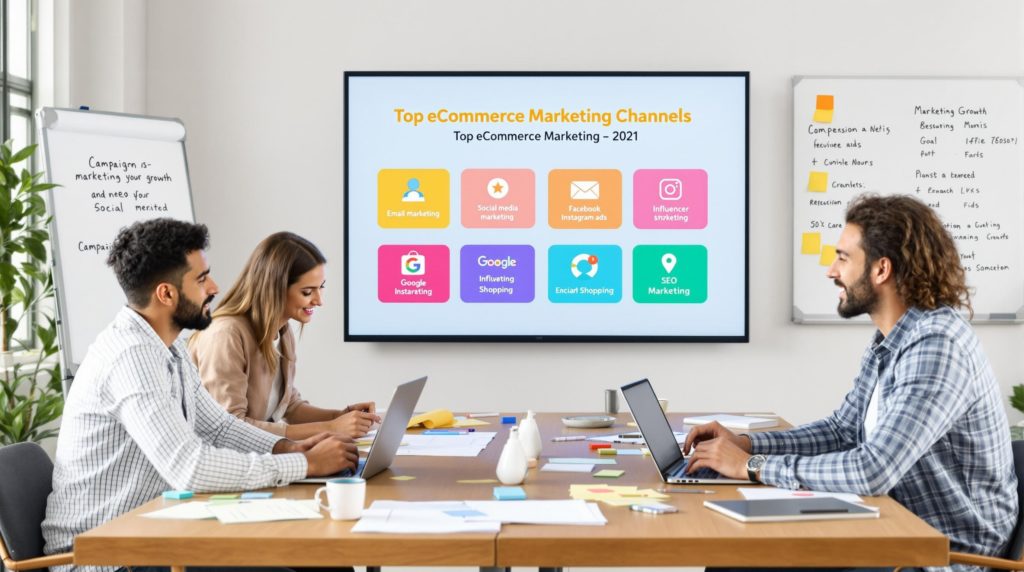eCommerce is now the fastest way to get products in front of consumers in an ever-growing market. With millions of shoppers online and thousands of competing merchants with online stores, companies have to scramble to seize the opportunity by applying the right market strategy to get their products to their target customers.
While there are several digital marketing strategies, throwing your money into all of them may not be ideal for getting the best return on investment. You need to understand the specific eCommerce marketing channels that will bring you the most value for your marketing dollars by placing your products in front of those most likely to purchase.
To be successful as an eCommerce business, it's essential to understand the impact of digital marketing online. It helps you to potentially reach millions of users and build strategies to capture the right prospects. It also offers ways to attract prospects and prompt them to finish sales even after deserting their shopping carts. While these are just some of the things digital marketing can do, there is an entire discipline to optimize the various marketing channels to give you the best bang for the buck.
Some of the popular marketing channels that will be effective are SEO, Content Marketing, Social Media Marketing, Influencer Marketing, etc. This article talks about what you need to know to craft the best digital marketing strategy.
Search engine optimization or SEO

SEO always be an essential part of digital marketing, and you need to make sure your site and product pages are all optimized for the exact keywords your target customers are looking for. That also means going beyond text search into search areas that are set to dominate. To make the most of it, optimize your site for:
Voice search
Consumers are increasingly using voice searches to find their products. About a third of the population of the United States uses voice search, and it is expected to grow at a 9.7% rate by 2021.
Voice searches are often in the form of phrases and questions such as: “Hey Google, where is a watch store near me?”. Optimizing your page for Trigger words also rewards big time.
Semantic search
Semantic search is the search engine's approach to zero in on the most accurate search result by understanding things such as the context of the query, the intent of the search, and the relationship between words.
It is the search engine trying to understand the language in voice searches. To optimize for it, generate content related to common queries at the beginning of the page before getting into the specifics.
AI in Search
Machine learning utilizes both texts and voice searches to optimize and nudge users towards asking the pertinent question that fetches them what they might be looking for.
It involves things like Query completion, related searches, and related products, which is more likely to help them land where they need to.
Pay per click or PPC
If you want your page to rank higher today on Google organically, it's almost impossible unless you've had a strong SEO strategy in place for a long time.
To speed it up and rank above your competitors in the top spot, social media publishers and search engines offer the pay-per-click ad model.
Once you bid on keywords to get to the top, there are other things like content quality, data feed management, campaign setup, and continued optimization that help float you to the top.
These are the most popular PPC methods:
- Google shopping ads: Google shopping ads is the best bet when it comes to a broad reach. Google shopping ads now account for 76.4% of retail search ad spending and generate over 85% of all clicks.
- Facebook ads: Facebook, with over 2.7 billion users, is the next best bet to maximize reach. Over 78% of American consumers report they found the product they were looking for on Facebook.
- Instagram ads: Instagram is a visually rich platform and works well for many luxury and niche brands. According to Instagram, 60% of users discovered new products on the forum. With a little over half of the 800 million users on the platform being millennials, Instagram is a great place to advertise for newer companies.
- YouTube ads: With YouTube ads, it's possible to reach a wider audience from all walks of life. It is a cost-effective marketing strategy that can target customers of all age groups.
Affiliate marketing
An affiliate for an eCommerce store is no different from the salesmen who go door to door to sell products, except where you work with an affiliate program where the sales associates direct some traffic towards your site and get paid according to your arrangement.
The affiliates already have a sizable audience in hand, and their reach is probably better than yours, and all they need to do is promote the products, and you get sales.
To know how well this works, consider that more than 80% of brands use affiliate marketing programs.
By getting started on an affiliate marketing program, you can quickly and economically drive traffic to your eCommerce store, all the while not paying anything upfront! To make it most effective, find an affiliate in your niche who can promote your products to potential buyers.
Work out the commission for the affiliate program and try to be more generous, especially if you are starting.
Social media marketing
Globally over 3.6 billion people use social media, and it is expected to grow to 4.41 billion by 2025. People spend hours every day on social media platforms such as Facebook, Instagram, and Twitter, a whole lot more than they do on search engines. However, this doesn't mean they all have an equal return on investment.
If you have a brand that specifically targets the millennials, Instagram is your better bet as over 60% of that demographic uses it. 90% of US marketers consider Instagram as the most effective platform for influencer marketing. Posts and stories by influencers and pages account for the most effective content type at 78% and 73%, respectively.
Using it effectively, your social media page needs to engage with the target audience with fresh and exceptional content and support causes that align with the business principles. Here's one effective way to do that:
Social media stories
Stories are the most efficient way to capture the attention of your target customers. On Instagram, more than 500 million people use stories every day.
The appeal of stories is because it disappears within 24 hours; therefore, there is a component of urgency that fuels the target customer's impulsivity to take actions.
Content Marketing
Content comes in all forms, such as written articles, video posts, infographics, blog posts, and sharing other content consumed by your audience and generating more leads.
When creating content, it's essential to keep in mind that its primary purpose is to add value to your customers and not boast about your company.
Strong content marketing revolves around things such as social causes and other areas that evoke an emotional response.
With that being said, here are some ways you can create engaging content:
- Video: It is estimated that 80% of all internet traffic will be dominated by videos. Your audience would love to watch a crisp video showing how your product works than to read lengthy descriptions. Good video content should get the point across quickly and elicit a strong feeling to take action.
- Images: Like with videos, images also can produce a strong emotional response from your customers. So invest time in getting shots that can tell a thousand words! However, the search engines can pick up physical information such as keywords and image descriptions along with text inside the image that tells it what the image is about.
- Webinars: Webinars fill a significant gap that no other content channel can: the personal connect. While your customers can engage with your periodic online posts, engaging with them live can build trust and brand authority and help you promote new products. It also establishes stronger customer loyalty and improves your search ranking.
- eBooks: Expertise is something that you can sell as a viable product if you can sit down and write an eBook. It can gain worldwide recognition for your brand and also make it easier for your customers to learn the finer details of what you have to offer.
- Blog posts: Blog posts are the oldest and one of the most effective ways to drive traffic to your site. You can use it to work on your SEO by publishing fresh content regularly and establish yourself as a brand expert while keeping your customers engaged.
Influencer marketing
To keep your eCommerce business successful, you have to pay to rise to the top. Big brands spend millions on securing their top internet advertising space, while the brands at the bottom have little to no visibility.

Influencer marketing is a fast and effective way to get noticed and get to business. Influence marketing is where you associate with known social media influencers to promote your brand and products. For example, if you have a line of sports drinks, you will have to associate with a famous fitness influencer to endorse your brand.
The strategy is highly effective since 49% of users say their purchase decisions were motivated and solidified by the influencers they follow on Twitter.
While top brands pick up the major celebrity influencers, smaller companies can reach a more targeted audience by collaborating with the right micro-influencers.
As a market, eCommerce is exceptionally competitive, with more than 7 million retailers online. Even if you can successfully capture their attention, it doesn't guarantee that it will lead to conversions.
To add to that, over 68% of prospects abandon their carts due to various reasons. Having influencers promote your brand to their social media followers will help a great deal for your marketing rather than to spend thousands on ads that may not return much.
Email marketing
Online retailers who have been in the business for a while know that Email marketing is still one of the most profitable and reliable methods.
This is because similar to personalized ads and landing pages, customized emails' exclusivity has a significant impact on the customers.
In its essence, email marketing is building a relationship with your customers. It involves sending marketing emails to existing customers or prospects to sell more products, educate them, or build loyalty.
Email marketing has several advantages, such as:
- Building an ongoing customer relationship. While social media helps you get new customers, emails allow you to retain the old ones. According to a Nielsen Study, about 66% of shoppers online prefer to stick to brands they are familiar with to buy any new products.
- Email marketing has a high return on investment. One study by DMA showed that for dollar companies spend on email marketing; their average return is $32.
- Email isn't at the mercy of the third-party gatekeepers. On social media platforms, tweaks to algorithms can completely derail distribution strategies.
Here is how you can get started:
- Pick the right email service provider who will offer you email marketing software that is cost-effective.
- Build your email list. Collect emails from everyone who has made a purchase or anyone interested in your offering. Make sure to offer them the option to opt-out.
- Have a sign-up form on your webpage and place it strategically so it won't form a wrong impression but stays compelling enough.
- Send emails legally and make exclusive deals and discounts. You could also send links to contest and educational content.
Direct Traffic
Direct traffic remains a relatively un-discussed marketing channel as it is most often associated with successfully established brands.
Leading eCommerce platforms get half of their traffic directly because of their long-term brand familiarity. Customers search straight for the eCommerce store to find what they are looking for.
A significant portion of this traffic is the URLs sent by friends or family or coworkers who take traffic to the eCommerce page. Since the source of how someone arrived cannot be tracked, it's also called ‘dark social'.
Since it is challenging to account for the source, there is a general rule of thumb: For every three people reaching the site through social means, there could be seven who will arrive from dark social!
This means that dark social is the third-largest contributor to traffic to your site. Therefore it is essential to design your landing pages for social shares and keep them mobile-friendly.
Conclusion
There are many marketing channels that all have different potential to give you the return on investment you seek to wrap it up. It should be clear at this point that the best way to go about is to start with more than one of these and pitch the most into the channel that is right for your business.
Alternatively, hiring digital marketing agencies is also an excellent idea if you are tight on budget to find the best source of marketing that will turn into conversions. If your budget allows for it, don't be afraid to experiment with something out of the ordinary because it might pay off big!
Guest Post Contribution from AdNabu
Creating an approved Google Shopping Feed & running profitable Google Ads is a multi-step process. AdNabu’s app helps you to easily create a Google Shopping feed & run profitable Google shopping Ads. All changes from your Shopify store are fetched and updated automatically in the feed.

